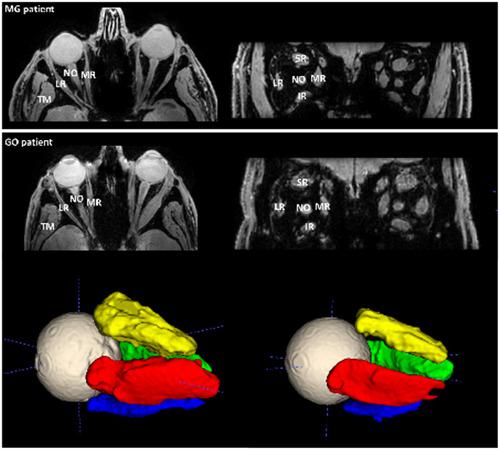当前位置:
X-MOL 学术
›
NMR Biomed.
›
论文详情
Our official English website, www.x-mol.net, welcomes your
feedback! (Note: you will need to create a separate account there.)
The feasibility of quantitative MRI of extra-ocular muscles in myasthenia gravis and Graves' orbitopathy.
NMR in Biomedicine ( IF 2.7 ) Pub Date : 2020-09-07 , DOI: 10.1002/nbm.4407 Kevin R Keene 1, 2 , Luc van Vught 1, 3 , Nienke M van de Velde 2 , Isabeau A Ciggaar 1, 3 , Irene C Notting 3 , Stijn W Genders 3 , Jan J G M Verschuuren 2, 4 , Martijn R Tannemaat 2 , Hermien E Kan 1, 4 , Jan-Willem M Beenakker 1, 3
NMR in Biomedicine ( IF 2.7 ) Pub Date : 2020-09-07 , DOI: 10.1002/nbm.4407 Kevin R Keene 1, 2 , Luc van Vught 1, 3 , Nienke M van de Velde 2 , Isabeau A Ciggaar 1, 3 , Irene C Notting 3 , Stijn W Genders 3 , Jan J G M Verschuuren 2, 4 , Martijn R Tannemaat 2 , Hermien E Kan 1, 4 , Jan-Willem M Beenakker 1, 3
Affiliation

|
Although quantitative MRI can be instrumental in the diagnosis and assessment of disease progression in orbital diseases involving the extra‐ocular muscles (EOM), acquisition can be challenging as EOM are small and prone to eye‐motion artefacts. We explored the feasibility of assessing fat fractions (FF), muscle volumes and water T2 (T2water) of EOM in healthy controls (HC), myasthenia gravis (MG) and Graves' orbitopathy (GO) patients. FF, EOM volumes and T2water values were determined in 12 HC (aged 22‐65 years), 11 MG (aged 28‐71 years) and six GO (aged 28‐64 years) patients at 7 T using Dixon and multi‐echo spin‐echo sequences. The EOM were semi‐automatically 3D‐segmented by two independent observers. MANOVA and t‐tests were used to assess differences in FF, T2water and volume of EOM between groups (P < .05). Bland–Altman limits of agreement (LoA) were used to assess the reproducibility of segmentations and Dixon scans. The scans were well tolerated by all subjects. The bias in FF between the repeated Dixon scans was −0.7% (LoA: ±2.1%) for the different observers; the bias in FF was −0.3% (LoA: ±2.8%) and 0.03 cm3 (LoA: ± 0.36 cm3) for volume. Mean FF of EOM in MG (14.1% ± 1.6%) was higher than in HC (10.4% ± 2.5%). Mean muscle volume was higher in both GO (1.2 ± 0.4 cm3) and MG (0.8 ± 0.2 cm3) compared with HC (0.6 ± 0.2 cm3). The average T2water for all EOM was 24.6 ± 4.0 ms for HC, 24.0 ± 4.7 ms for MG patients and 27.4 ± 4.2 ms for the GO patient. Quantitative MRI at 7 T is feasible for measuring FF and muscle volumes of EOM in HC, MG and GO patients. The measured T2water was on average comparable with skeletal muscle, although with higher variation between subjects. The increased FF in the EOM in MG patients suggests that EOM involvement in MG is accompanied by fat replacement. The unexpected EOM volume increase in MG may provide novel insights into underlying pathophysiological processes.
中文翻译:

重症肌无力和 Graves 眼眶病眼外肌定量 MRI 的可行性。
尽管定量 MRI 有助于诊断和评估涉及眼外肌 (EOM) 的眼眶疾病的疾病进展,但由于 EOM 很小且容易出现眼动伪影,因此获取可能具有挑战性。我们探讨了在健康对照 (HC)、重症肌无力 (MG) 和格雷夫斯眼眶病 (GO) 患者中评估EOM 的脂肪分数 (FF)、肌肉体积和水 T2 (T2水)的可行性。FF、EOM 体积和 T2水值在 12 名 HC(22-65 岁)、11 名 MG(28-71 岁)和 6 名 GO(28-64 岁)患者中使用 Dixon 和多回波在 7 T 下测定自旋回波序列。EOM 由两个独立的观察者半自动 3D 分割。MANOVA 和 t 检验用于评估 FF、T2水的差异和组间 EOM 的体积 ( P < .05)。Bland-Altman 协议限制 (LoA) 用于评估分割和 Dixon 扫描的再现性。所有受试者都能很好地耐受这些扫描。对于不同的观察者,重复 Dixon 扫描之间的 FF 偏差为 -0.7%(LoA:±2.1%);FF 中的偏差为 -0.3% (LoA: ±2.8%) 和 0.03 cm 3 (LoA: ± 0.36 cm 3 ) 的体积。MG 中 EOM 的平均 FF (14.1% ± 1.6%) 高于 HC (10.4% ± 2.5%)。与 HC (0.6 ± 0.2 cm 3 )相比,GO (1.2 ± 0.4 cm 3 ) 和 MG (0.8 ± 0.2 cm 3 ) 的平均肌肉体积更高。平均T2水对于所有 EOM,HC 为 24.6 ± 4.0 ms,MG 患者为 24.0 ± 4.7 ms,GO 患者为 27.4 ± 4.2 ms。7 T 的定量 MRI 可用于测量 HC、MG 和 GO 患者的 EOM 的 FF 和肌肉体积。测量的 T2水平均与骨骼肌相当,尽管受试者之间的差异更大。MG 患者 EOM 中 FF 的增加表明 EOM 参与 MG 伴随着脂肪替代。MG 中意外的 EOM 体积增加可能为潜在的病理生理过程提供新的见解。
更新日期:2020-09-07
中文翻译:

重症肌无力和 Graves 眼眶病眼外肌定量 MRI 的可行性。
尽管定量 MRI 有助于诊断和评估涉及眼外肌 (EOM) 的眼眶疾病的疾病进展,但由于 EOM 很小且容易出现眼动伪影,因此获取可能具有挑战性。我们探讨了在健康对照 (HC)、重症肌无力 (MG) 和格雷夫斯眼眶病 (GO) 患者中评估EOM 的脂肪分数 (FF)、肌肉体积和水 T2 (T2水)的可行性。FF、EOM 体积和 T2水值在 12 名 HC(22-65 岁)、11 名 MG(28-71 岁)和 6 名 GO(28-64 岁)患者中使用 Dixon 和多回波在 7 T 下测定自旋回波序列。EOM 由两个独立的观察者半自动 3D 分割。MANOVA 和 t 检验用于评估 FF、T2水的差异和组间 EOM 的体积 ( P < .05)。Bland-Altman 协议限制 (LoA) 用于评估分割和 Dixon 扫描的再现性。所有受试者都能很好地耐受这些扫描。对于不同的观察者,重复 Dixon 扫描之间的 FF 偏差为 -0.7%(LoA:±2.1%);FF 中的偏差为 -0.3% (LoA: ±2.8%) 和 0.03 cm 3 (LoA: ± 0.36 cm 3 ) 的体积。MG 中 EOM 的平均 FF (14.1% ± 1.6%) 高于 HC (10.4% ± 2.5%)。与 HC (0.6 ± 0.2 cm 3 )相比,GO (1.2 ± 0.4 cm 3 ) 和 MG (0.8 ± 0.2 cm 3 ) 的平均肌肉体积更高。平均T2水对于所有 EOM,HC 为 24.6 ± 4.0 ms,MG 患者为 24.0 ± 4.7 ms,GO 患者为 27.4 ± 4.2 ms。7 T 的定量 MRI 可用于测量 HC、MG 和 GO 患者的 EOM 的 FF 和肌肉体积。测量的 T2水平均与骨骼肌相当,尽管受试者之间的差异更大。MG 患者 EOM 中 FF 的增加表明 EOM 参与 MG 伴随着脂肪替代。MG 中意外的 EOM 体积增加可能为潜在的病理生理过程提供新的见解。











































 京公网安备 11010802027423号
京公网安备 11010802027423号